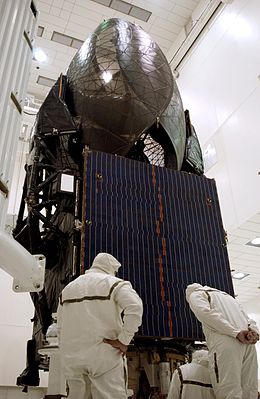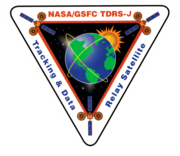 TDRS-J undergoing processing before launch | |
| Mission type | Communication |
|---|---|
| Operator | NASA |
| COSPAR ID | 2002-055A |
| SATCAT no. | 27566 |
| Mission duration | Planned: 20 years Elapsed: 21 years, 9 months, 17 days |
| Spacecraft properties | |
| Bus | BSS-601 |
| Manufacturer | Boeing SDC |
| Launch mass | 3,180 kg (7,010 lb)[1] |
| Start of mission | |
| Launch date | 5 December 2002, 02:42 UTC |
| Rocket | Atlas IIA |
| Launch site | Cape Canaveral SLC-36A |
| Contractor | ILS |
| Orbital parameters | |
| Reference system | Geocentric |
| Regime | Geostationary |
| Longitude | 153° West 151° West ~42-40° West (2004—) |
| Perigee altitude | 35,766 kilometers (22,224 mi)[2] |
| Apogee altitude | 35,798 kilometers (22,244 mi)[2] |
| Inclination | 6.09 degrees[2] |
| Period | 1435.86 minutes[2] |
| Epoch | 1 January 2004[2] |

| |
TDRS-10, known before launch as TDRS-J, is an American communications satellite which is operated by NASA as part of the Tracking and Data Relay Satellite System. It was constructed by the Boeing Satellite Development Center, formerly Hughes Space and Communications, and is based on the BSS-601 satellite bus.[3] It was the third and final Advanced TDRS, or second-generation Tracking and Data Relay Satellite, to be launched.
- ^ "UCS Satellite Database". Union of Concerned Scientists. 1 July 2009. Retrieved 10 August 2009.
- ^ a b c d e McDowell, Jonathan. "Satellite Catalog". Jonathan's Space Page. Retrieved 3 May 2018.
- ^ Krebs, Gunter. "TDRS 8, 9, 10". Gunter's Space Page. Retrieved 10 August 2009.